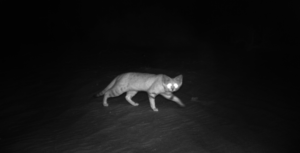In a vast expanse of untouched Abu Dhabi desert, scientists from the Environment Agency (EAD) are busy protecting a clowder of sand cats from extinction.
In recent years, sand cat populations have declined as their arid natural habitat turned into a urban cityscape and matted network of transport lines, experts say.
Now EAD researchers are monitoring the number of cats to see how their population and eco-systems can be protected. UAE researchers made a significant breakthrough last year when they photographed a clan of three sand cats in Baynouna, in Abu Dhabi’s Western Region.
The sighting made global news when it was first revealed in the European Journal of Wildlife Research last month.
Dr Shakeel Ahmed, an assistant scientist on EAD’s sand cat programme, said: “Last year, in December, we found three individuals, but this is still the start of our research, and we are expanding the area to find more undetected populations of the sand cat.”
The sightings were made in a area of juts 1,990sqm of arid desert in Baynouna. The research, which first started in March 2015, will now be expanded to include more areas, after initially focusing on a very small area of 90sqm out of 776sqkm.
The last recorded census was in 2005, when experts estimated there was a population of fewer than 250 cats in the UAE. With the species regarded as a national treasure, their survival has become a priority for conservationists.
Ahmed said: “It’s an important species, it’s a native species, and they’re elusive and nocturnal – not much is known about them.”
His colleague, Dr Salim Javed, who manages the Terrestrial and Marine Biodiversity Scientists at EAD, said: “Our effort is to protect such an important and flagship species which is typical to the desert environment in Abu Dhabi and the UAE.”
In coming months, EAD researchers will partner with Al Ain Zoo to carry out genetic tests on the desert felines, Ahmed says.
He added: “This will establish the similarities with the species in neighbouring countries.” Al Ain Zoo will provide vets to help lay traps to catch and collar the cats.
They will take blood samples for genetic studies to determine the size of their population and nature of the conservation programme.
Al Ain Zoo has the largest captive population of the sand cats in the world, numbering 34, demonstrating just how rare they have become.
Hessa Al Qahtani, who leads the sand cat research at al Ain Zoo, said that the fast development of the country has come at a cost for the species.
She said: “In the UAE they are endangered and the reason for that is the loss of the habitat and also the loss of their food, which is also affected by habitat loss.”
Al Qahtani added: “New developments, building roads everywhere, farms, pollution – a combination of all these things affect its habitat.”
Source: 7DAYS











